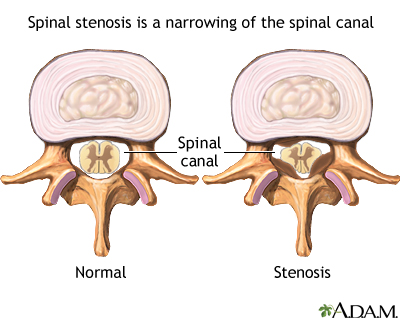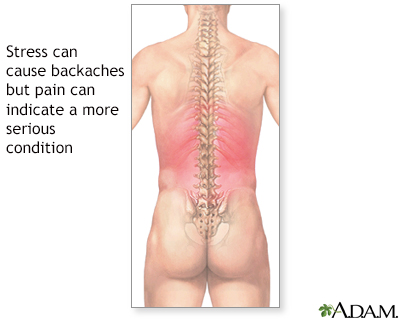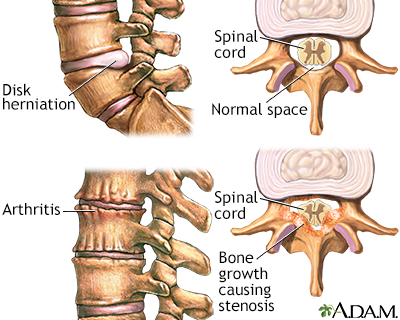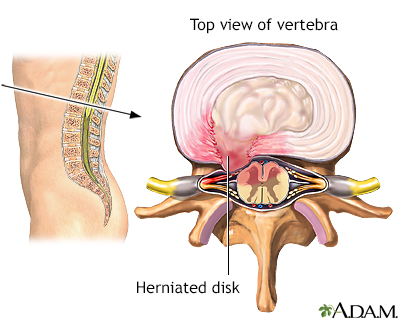Low back pain - chronic
Nonspecific back pain; Backache - chronic; Lumbar pain - chronic; Pain - back - chronic; Chronic back pain - low
Low back pain refers to pain that you feel in your lower back. You may also have back stiffness, decreased movement of the lower back, and difficulty standing straight.
Low back pain that is long-term is called chronic low back pain.
Images




I Would Like to Learn About:
Causes
Low back pain is common. Almost everyone has back pain at some time in their life. Often, the exact cause of the pain cannot be found.
A single event may not have caused your pain. You may have been doing many activities, such as lifting the wrong way, for a long time. Then suddenly, one simple movement, such as reaching for something or bending from your waist, leads to pain.
Many people with chronic back pain have arthritis. Or they may have extra wear and tear of the spine, which may be due to:
- Heavy use from work or sports
- Injuries or fractures
- Surgery
You may have had a herniated disk, in which part of the spinal disk pushed onto nearby nerves. Normally, the disks provide space and cushion in your spine. If these disks dry out and become thinner and more brittle, you can lose movement in the spine over time.
If the spaces between the spinal nerves and spinal cord become narrowed, this can lead to spinal stenosis. These problems are called degenerative joint or spine disease.
Other possible causes of chronic low back pain include:
- Curvature of the spine, such as scoliosis or kyphosis
- Medical problems, such as fibromyalgia or rheumatoid arthritis
- Piriformis syndrome, a pain disorder involving a muscle in the buttocks called the piriformis muscle
You are at greater risk for low back pain if you:
- Are over age 30
- Are overweight
- Are pregnant
- Do not exercise
- Feel stressed or depressed
- Have a job in which you have to do heavy lifting, bending and twisting, or that involves whole body vibration, such as truck driving or using a sandblaster
- Smoke
Symptoms
Symptoms may include any of the following:
- Dull aching pain
- Sharp pain
- Tingling or burning sensation
- Weakness in your legs or feet
Low back pain can differ from person to person. The pain may be mild, or it can be so severe that you cannot move.
Depending on the cause of your back pain, you may also have pain in your leg, hip, or on the bottom of your foot.
Exams and Tests
During the physical exam, the health care provider will try to pinpoint the location of the pain and figure out how it affects your movement.
Other tests you have depend on your medical history and symptoms.
Tests may include:
- Blood tests, such as a complete blood count and erythrocyte sedimentation rate
- CT scan of the lower spine
- MRI scan of the lower spine
- Myelogram (x-ray or CT scan of the spine after dye has been injected into the spinal column)
- X-ray of the lumbosacral spine
Treatment
Your back pain may not go away completely, or it may get more painful at times. Learn to take care of your back at home and how to prevent repeat episodes of back pain. This can help you continue with your normal activities.
Your provider may recommend measures to reduce your pain, including:
- A back brace to support your back
- Cold packs and heat therapy
- Traction
- Physical therapy, involving stretching and strengthening exercises
- Counseling to learn ways to understand and manage your pain
These other health care providers may also help:
- Massage therapist
- Someone who performs acupuncture
- Someone who does spinal manipulation (a chiropractor, osteopathic physician, or physical therapist)
If needed, your provider may prescribe medicines to help with your back pain:
- Aspirin, naproxen (Aleve), or ibuprofen (Advil), which you can buy without a prescription
- Low doses of prescription medicines
- Narcotics or opioids when the pain is severe
If your pain does not improve with medicine, physical therapy, and other treatments, your provider may recommend an epidural injection.
Spinal surgery is considered only if you have nerve damage or bone damage that is causing the back pain does not heal after a long time.
In some patients, a spinal cord stimulator can help reduce back pain.
Other treatments that may be recommended if your pain does not improve with medicine and physical therapy include:
- Spinal surgery, only if you have nerve damage or the cause of your pain does not heal after a long time
- Spinal cord stimulation, in which a small device sends an electric current to the spine to block pain signals
Some people with low back pain may also need:
- Job changes
- Job counseling
- Job retraining
- Occupational therapy
Outlook (Prognosis)
Most back problems get better on their own. Follow your provider's advice on treatment and self-care measures.
When to Contact a Medical Professional
Contact your provider if you have severe back pain that does not go away. Call right away if you have numbness, loss of movement, weakness, or bowel or bladder changes.
Related Information
DiskectomyForaminotomy
Laminectomy
Spinal fusion
Sciatica
Spine surgery - discharge
References
Abd OHE, Amadera JED. Low back strain or sprain. In: Frontera WR, Silver JK, Rizzo TD Jr, eds. Essentials of Physical Medicine and Rehabilitation: Musculoskeletal Disorders, Pain, and Rehabilitation. 4th ed. Philadelphia, PA: Elsevier; 2019:chap 48.
Dixit R. Low back pain. In: Firestein GS, Budd RC, Gabriel SE, Koretzky GA, McInnes IB, O'Dell JR, eds. Firestein & Kelley's Textbook of Rheumatology. 11th ed. Philadelphia, PA: Elsevier; 2021:chap 50.
Malik K, Nelson A. Overview of low back pain disorders. In: Benzon HT, Raja SN, Liu SS, Fishman SM, Cohen SP, eds. Essentials of Pain Medicine. 4th ed. Philadelphia, PA: Elsevier; 2018:chap 24.
BACK TO TOPReview Date: 4/27/2023
Reviewed By: Linda J. Vorvick, MD, Clinical Professor, Department of Family Medicine, UW Medicine, School of Medicine, University of Washington, Seattle, WA. Also reviewed by David C. Dugdale, MD, Medical Director, Brenda Conaway, Editorial Director, and the A.D.A.M. Editorial team.

Health Content Provider
06/01/2025
|
A.D.A.M., Inc. is accredited by URAC, for Health Content Provider (www.urac.org). URAC's accreditation program is an independent audit to verify that A.D.A.M. follows rigorous standards of quality and accountability. A.D.A.M. is among the first to achieve this important distinction for online health information and services. Learn more about A.D.A.M.'s editorial policy, editorial process and privacy policy. A.D.A.M. is also a founding member of Hi-Ethics. This site complied with the HONcode standard for trustworthy health information from 1995 to 2022, after which HON (Health On the Net, a not-for-profit organization that promoted transparent and reliable health information online) was discontinued. |
The information provided herein should not be used during any medical emergency or for the diagnosis or treatment of any medical condition. A licensed medical professional should be consulted for diagnosis and treatment of any and all medical conditions. Links to other sites are provided for information only -- they do not constitute endorsements of those other sites. © 1997- 2025 A.D.A.M., a business unit of Ebix, Inc. Any duplication or distribution of the information contained herein is strictly prohibited.
